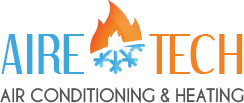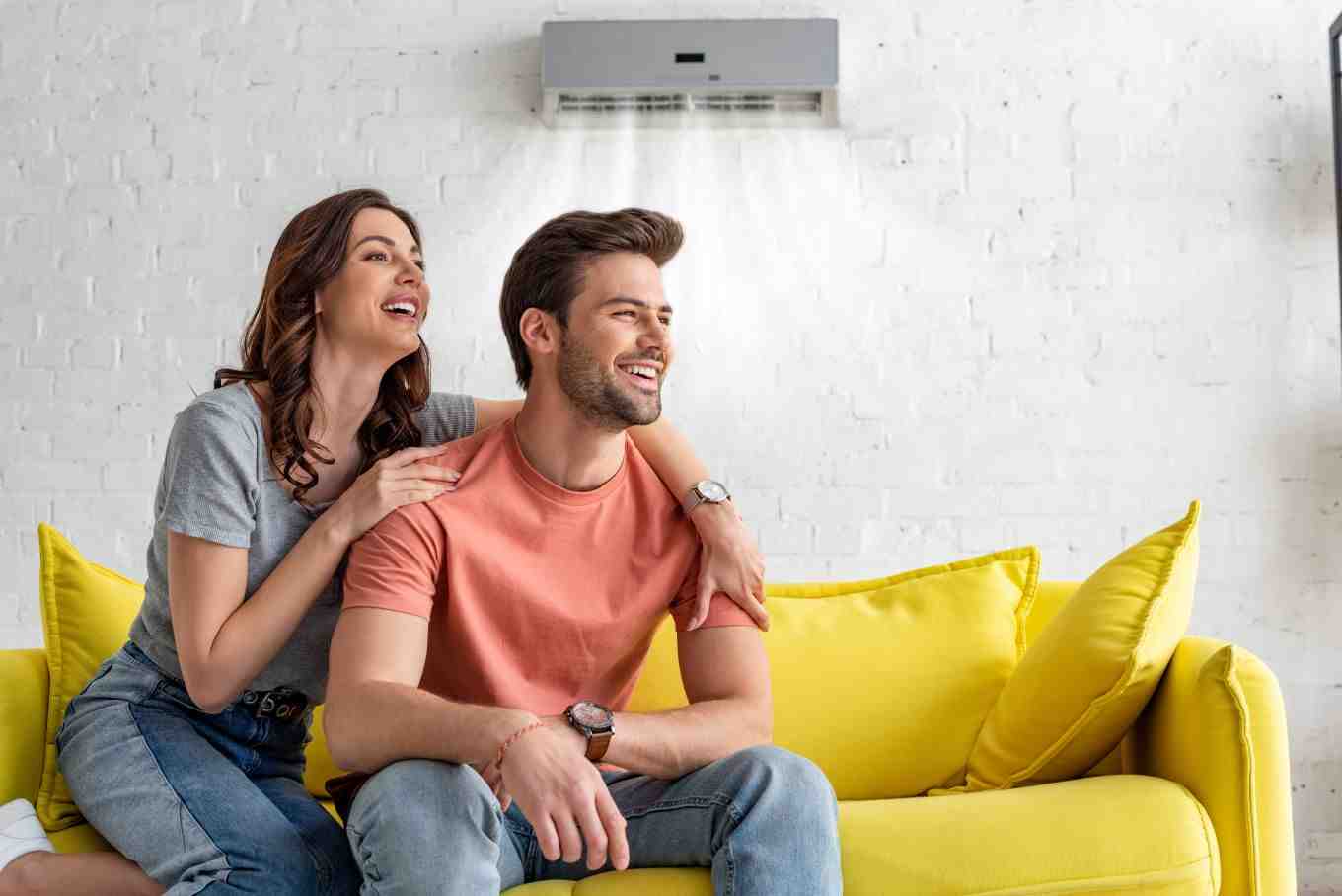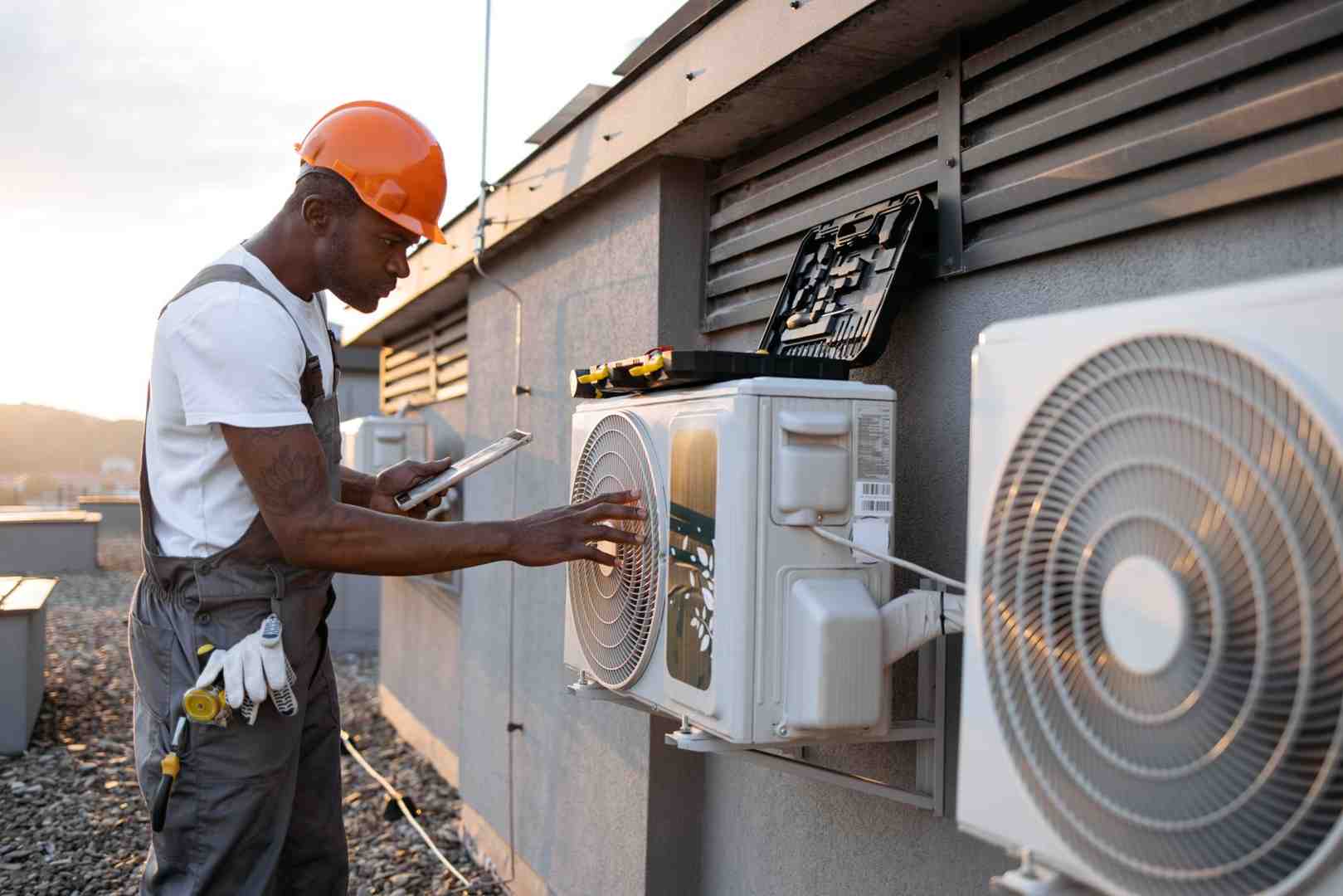Why Energy Efficiency Matters for Air Conditioners
Understanding the EER (Energy Efficiency Ratio) of an air conditioner is crucial if you’re looking to reduce your energy bills and keep your home comfortable. The EER measures the cooling efficiency of an air conditioner by comparing its cooling capacity (measured in BTUs) to its power input (measured in watts).
Here’s what you need to know right away:
- EER stands for Energy Efficiency Ratio.
- EER is calculated: Cooling Capacity (BTU) / Power Input (Watts)
- Higher EER means better energy efficiency.
During hot summer days, a well-rated EER unit can make a noticeable difference. It provides more cooling with less energy, which translates to savings on your utility bills and fewer breakdowns. Efficient air conditioners not only save money but also reduce environmental impact by consuming less electricity.
Air conditioners with high EER ratings operate more effectively, making your living space more comfortable. They are designed to function efficiently even under demanding conditions, such as a 95°F outside temperature and an 80°F inside temperature with 50% relative humidity.
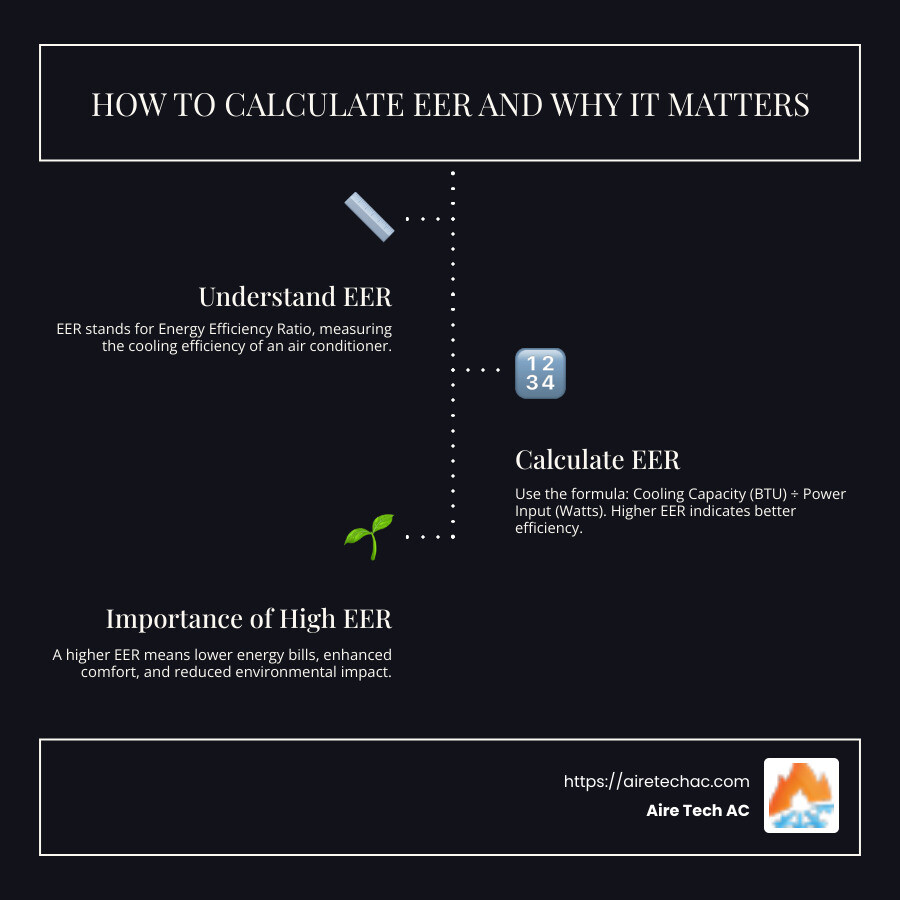
Similar topics to eer:
- are energy efficient air conditioners tax deductible
- how to check energy efficiency of air conditioner
What is EER?
How is EER Calculated?
The Energy Efficiency Ratio (EER) is a simple yet powerful metric that helps you understand how efficiently an air conditioner operates. It measures the cooling capacity of the unit in BTUs (British Thermal Units) against the electrical power it consumes in watts.
Here’s the straightforward formula:
EER = Cooling Capacity (BTU) / Power Input (Watts)
Imagine your air conditioner as a machine tasked with moving heat. The cooling output is the amount of heat it can remove from your home, while the power input is the electrical energy it needs to do so. The higher the EER, the more efficient the unit is at converting electricity into cooling.
Why EER Matters
Understanding and considering the EER of an air conditioner can significantly impact your wallet and the environment. Here’s why:
Energy Savings
A higher EER means the unit uses less electricity to provide the same amount of cooling. This translates directly into lower energy bills. For instance, if your air conditioner has an EER of 15 and another has an EER of 10, the first one is 50% more efficient. Over time, this efficiency can lead to substantial savings.
Cost Reduction
Using an air conditioner with a high EER can reduce the overall cost of running your HVAC system. This includes not only the direct cost of electricity but also potential savings from reduced wear and tear. Efficient units are less likely to overheat and break down.
Environmental Impact
High-efficiency air conditioners are better for the environment. They consume less power, which means less demand on power plants. This, in turn, leads to a reduction in greenhouse gas emissions. By opting for a unit with a high EER, you’re contributing to a greener planet.
HVAC Performance
Units with higher EER ratings generally perform better under extreme conditions. For example, an air conditioner operating in a 95°F outside temperature and 80°F inside temperature with 50% relative humidity will maintain optimal performance if it has a high EER. This ensures your home stays comfortable even during the hottest days.
In summary, the EER of an air conditioner is a critical factor in determining its efficiency, cost-effectiveness, and environmental impact. By understanding and utilizing this ratio, you can make informed decisions that benefit both your wallet and the planet.
Understanding EER Ratings
What is a Good EER?
When shopping for an air conditioner, you might wonder, “What is a good EER?” Simply put, a good EER is one that indicates high efficiency. Generally, an EER of 8.5 and above is considered good. Higher ratings mean better energy efficiency, which translates to lower energy bills and reduced environmental impact.
For top-of-the-line efficiency, look for air conditioners with an EER of 12 or higher. These units are often Energy Star certified, meaning they meet stringent energy efficiency guidelines set by the U.S. Environmental Protection Agency. Energy Star-certified units are at least 15% more efficient than standard models, making them a smart choice for both your wallet and the environment.
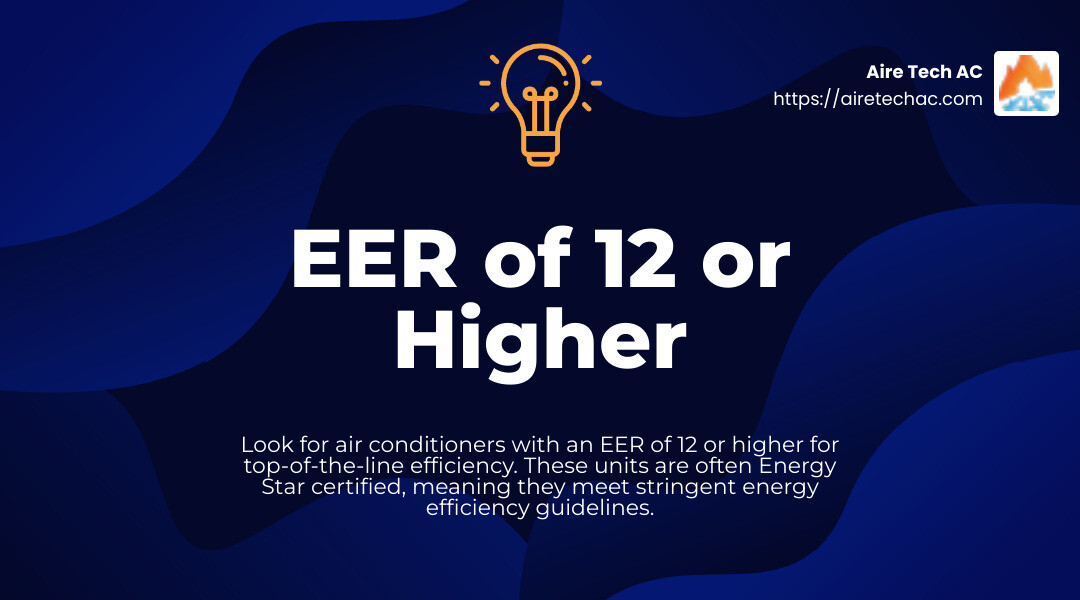
Comparing EER and SEER
You may also come across another term: SEER (Seasonal Energy Efficiency Ratio). While both EER and SEER measure efficiency, they do so in different ways.
- EER measures efficiency at a specific, constant temperature (usually 95°F outside and 80°F inside).
- SEER measures efficiency over an entire cooling season, taking into account varying temperatures and conditions.
Think of EER as a snapshot of performance under peak conditions, while SEER provides a broader view of performance over time.
For instance, if you live in a region with consistently high temperatures, a high EER rating is crucial. It ensures that your air conditioner performs efficiently even on the hottest days. Conversely, if your climate varies, focusing on SEER might be more beneficial.
In summary, both EER and SEER are valuable metrics. EER is essential for understanding peak performance, while SEER offers a comprehensive look at seasonal efficiency. By considering both, you can make an informed decision that ensures optimal comfort and energy savings year-round.
Factors Affecting EER
Temperature and Humidity
The Energy Efficiency Ratio (EER) of an air conditioner is highly influenced by temperature and humidity. EER is calculated under specific conditions: an outside temperature of 95°F, an inside temperature of 80°F, and 50% relative humidity. These conditions are set to simulate a hot day when your air conditioner works the hardest.
But real-world conditions vary.
- Higher outdoor temperatures mean your AC has to work harder, affecting its efficiency.
- Indoor temperatures you set on your thermostat also play a role. A cooler setting means more work for your AC.
- Humidity levels impact performance too. High humidity can make your AC less efficient because it needs to remove moisture from the air.
In short, while EER gives you a snapshot of performance under specific conditions, real-world factors like local climate and your thermostat settings can impact efficiency.
Installation and Maintenance
Proper installation and regular maintenance are key to ensuring your air conditioner operates at its best EER.
- Proper Installation:
- Make sure your AC unit is installed by professionals. Poor installation can lead to issues like improper airflow direction and reduced efficiency.
- Thermostat placement is crucial. Place it away from heat sources like windows and appliances to get accurate readings.
- Regular Maintenance:
- Clean the outdoor coil: A dirty coil restricts airflow and heat transfer, making your AC work harder.
- Clean the evaporator coil: This helps maintain good airflow and prevents mold and bacteria build-up.
- Check refrigerant levels: Low levels can reduce cooling capability, causing the system to run longer and use more energy.
- Airflow Direction:
- Ensure that nothing blocks the airflow around the unit. Good airflow helps the AC unit work more efficiently.
- Smart Thermostats:
- Installing a smart thermostat can help you manage temperature settings more effectively, ensuring optimal performance.
By focusing on these factors, you can maximize your air conditioner’s EER and enjoy better energy efficiency.
How to Choose an Air Conditioner with a High EER
Sizing and Selecting
Choosing the right air conditioner for your room involves more than just picking a high EER unit. Proper sizing and selection are crucial to ensure efficiency and comfort.
First, determine the room size. The cooling capacity of an air conditioner is measured in BTU per hour. A common rule of thumb is that an air conditioner needs 20 BTU for each square foot of living space. Here’s a simple table to guide you:
| Room Size (sq. ft.) | Required BTU/hr |
|---|---|
| 100 – 150 | 5,000 |
| 150 – 250 | 6,000 |
| 250 – 300 | 7,000 |
| 300 – 350 | 8,000 |
| 350 – 400 | 9,000 |
| 400 – 450 | 10,000 |
| 450 – 550 | 12,000 |
| 550 – 700 | 14,000 |
Other factors also affect the BTU requirement:
- Room height: Higher ceilings require more cooling power.
- Local climate: Hotter climates need more BTUs.
- Shading: Rooms with lots of sunlight need more cooling.
- Window size: Larger windows can let in more heat.
Verify electrical requirements. Smaller units drawing less than 7.5 amps can use standard 120-volt outlets. Larger units may need dedicated circuits, and the largest units require 240-volt circuits.
Features to Look For
When selecting an air conditioner, look for features that improve efficiency and convenience:
- Easy-to-clean filter: A filter that slides out easily makes maintenance simpler, ensuring your unit runs efficiently.
- Digital thermostat: A digital readout helps you set precise temperatures, optimizing energy use.
- Built-in timer: This feature lets you program the unit to turn on or off at specific times, saving energy when you’re not home.
- Fan control: Features like Power Thrust or Super Thrust can direct airflow farther into the room, ensuring even cooling.
- Airflow direction: If you’re mounting the unit near a corner, choose one that can direct airflow in the desired direction.
By considering these factors, you can choose an air conditioner that not only has a high EER but also meets your specific needs for efficiency and comfort.
Frequently Asked Questions about EER
What is the meaning of EER?
EER stands for Energy Efficiency Ratio. It measures how efficiently an air conditioner uses electrical energy to transfer heat from inside your home to the outside.
In simple terms, EER is a ratio of the cooling capacity (measured in BTUs) to the power input (measured in watts). This ratio tells you how many BTUs of cooling output you get for each watt of electrical energy the air conditioner uses.
For example, if an air conditioner has a cooling capacity of 10,000 BTUs and uses 1,000 watts of power, its EER would be 10.
Higher EER values indicate better efficiency.
What is a good EER?
A good EER rating typically starts at 8.5 and above. Units with higher EER ratings are more energy-efficient, meaning they provide more cooling for each watt of electricity used.
For the best energy efficiency, look for air conditioners with an Energy Star certification. These units meet strict guidelines set by the U.S. Environmental Protection Agency (EPA) and the Department of Energy (DOE). They are guaranteed to be at least 15% more efficient than standard models.
How is the EER calculated?
Calculating EER involves a simple formula:
[ text{EER} = frac{text{Cooling Output (BTUs)}}{text{Power Input (Watts)}} ]
Here’s a step-by-step breakdown:
- Determine the cooling output: This is the amount of heat the air conditioner can remove from a room, measured in BTUs (British Thermal Units).
- Measure the power input: This is the amount of electrical power the air conditioner uses, measured in watts.
- Apply the formula: Divide the cooling output by the power input.
For example, if an air conditioner provides 12,000 BTUs of cooling and uses 1,200 watts of power, its EER would be:
[ text{EER} = frac{12,000 text{ BTUs}}{1,200 text{ watts}} = 10 ]
This means the unit delivers 10 BTUs of cooling for every watt of electricity it consumes.
EER is typically measured at a specific operating point, usually at an outdoor temperature of 95°F and an indoor temperature of 80°F with 50% relative humidity. This standardization ensures that EER ratings are consistent and comparable across different units.
Understanding EER can help you make informed decisions about which air conditioner will be most efficient and cost-effective for your home.

Call Aire Tech Today!
Energy efficiency in air conditioners is crucial for both cost savings and environmental impact. Understanding the Energy Efficiency Ratio (EER) helps you make informed decisions about which air conditioner to buy, ensuring you get the most cooling for the least amount of energy.
Energy Efficiency and Cost Savings
A higher EER means your air conditioner is more efficient, translating to lower utility bills. For example, an air conditioner with an EER of 15 will use less electricity to cool your home compared to one with an EER of 10. This efficiency doesn’t just save you money; it also reduces your carbon footprint, making it a win-win for you and the environment.
HVAC Performance
The performance of your HVAC system is directly related to its EER. Units with higher EER ratings are designed to perform optimally even in extreme temperatures, such as the 95°F outdoor temperature standard used in EER calculations. This is particularly important for those living in hot, humid climates like the Southern U.S.
Why Aire Tech AC?
At Aire Tech AC, we specialize in air conditioning installation and maintenance, ensuring your system operates at peak efficiency. Based in Perris, CA, our commitment to top-notch customer service sets us apart. We aim to make every service experience the best possible for our customers.
Customer Service in Perris, CA
Our team is dedicated to helping you choose the right air conditioner for your needs. We offer personalized advice and expert installation to maximize your system’s efficiency. Whether you’re upgrading an old unit or installing a new one, we provide the guidance and support you need.
For more information on choosing an energy-efficient air conditioner, visit our Air Conditioning Services page and get in touch with our team today.
By focusing on energy efficiency, you not only save money but also contribute to a healthier planet. With Aire Tech AC, you can be confident that you’re making a smart investment in your home’s comfort and sustainability.

